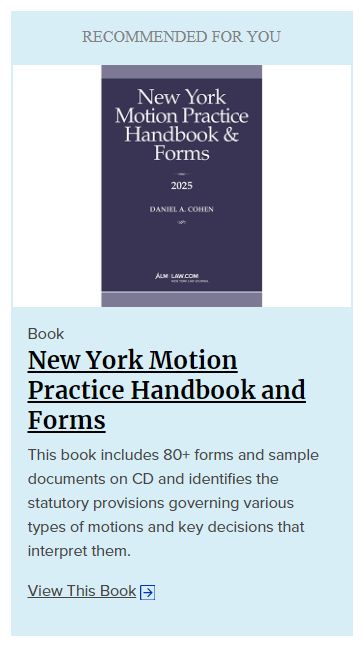Imagine that you bring a motion in New York Supreme Court, and you do so by order to show cause, but the judge refuses to sign the order to show cause, leaving the motion in limbo. The judge's refusal to sign is not appealable under New York law; there is no decision or order to appeal from. What options do you have? Ostensibly, CPLR Section 5704 ("Review of ex parte orders") provides an avenue for Appellate Division review of such a refusal to sign an order to show cause. Unfortunately, however, New York courts have yet to provide clear guidance on when such applications will or will not be granted. How CPLR Section 5704 applications are presently handled also highlights significant procedural differences between the Appellate Division Departments that linger despite the introduction of the uniform Practice Rules of the Appellate Division in 2018. The lower courts and litigants would be well served by the Departments adopting clear, uniform substantive and procedural guidelines for CPLR Section 5704 applications to reduce confusion and inconsistency.
Substantive Confusion
CPLR Section 5704(a) provides, in part, that: "the appellate division or a justice thereof may vacate or modify any order granted without notice to the adverse party ... and the appellate division may grant any order or provisional remedy applied for without notice to the adverse party and refused by any court or a judge thereof from which appeal would lie to such appellate division." When a Supreme Court justice "declines to sign the ... order to show cause" the remedy is for the movant to "have this court review ... the refusal to sign the order to show cause" pursuant to "CPLR 5704[a]." See Cypress Hills Management. v. Lempenski, 173 A.D.3d 830, 830-31 (2d Dep't 2019).
Notwithstanding, none of the Departments have provided clear guidance for when they will or will not grant a CPLR Section 5704 application. Indeed, none of the appellate courts have articulated even the elements applicants need to demonstrate for the court to grant a Section 5704 application. Nor have the Departments agreed on the extent to which a court can grant the underlying, substantive relief sought by the applicant on the originally unsigned order to show cause.
The Third Department has, when presented with CPLR Section 5704 applications, sometimes granted the relief sought in the initial order to show cause based upon an independent review of the record and the applicable precedent, as in Martin Operating v. Hertzan, 106 A.D.2d 784 (3d Dep't 1984) and Martin v. Hunt, 40 A.D.2d 571 (3d Dep't 1972). Somewhat similarly, the Second Department appears to focus on the papers filed in Supreme Court, and performs an independent analysis of those papers to determine whether relief is warranted. See, e.g., Trump v. Trump, Case No. 2020-0527, M271756 (2d Dep't July 1, 2020) (later modified on July 2, 2020); Matter of Curcio v. Curcio, 183 A.D.3d 726 (2d Dep't 2020).
The First Department, by stark contrast, has eschewed review of the underlying merits. In Tejeda v. Woodycrest Realty, 39 A.D.3d 210 (1st Dep't 2007), the First Department granted the CPLR Section 5704 application interposed, without explanation, but solely to the extent it directed the court below to decide the applicant's motion. In Chi Young Lee v. Osorio, 184 A.D.3d 417 (1st Dep't 2020), the First Department expressly stated that "review under CPLR 5704 would not ... address the merits of the motion defendant sought to make by order to show cause."

Additionally, the courts frequently grant or deny CPLR §5704 applications without any explanation, as in Tejeda and City of New York v. Freid, 2019 NY Slip Op 84373(U) (1st Dep't Nov. 19, 2019).
The courts are also inconsistent in how, and when, they treat a notice of appeal, filed without explicit reference to CPLR Section 5704, as CPLR Section 5704 applications. In some cases, like the First Department Tejeda decision or the Curcio Second Department decision, the courts have been willing to treat notices of appeal or other appellate motions as being CPLR Section 5704 applications even where the applicant did not request relief under that provision. In other cases, the First and Second Departments have refused to treat an appeal from an ex parte order as being a CPLR Section 5704 application, as has the Fourth Department. See, e.g., Weir v. Montefiore Medical Center, 208 A.D.3d 1122 (1st Dep't 2022); Wells Fargo Bank, N.A. v. Barasch, 188 A.D.3d 955 (2d Dep't 2020); Juliano v. Genesee Gateway, 188 A.D.3d 1680 (4th Dep't 2020).
In short, litigants seeking relief from Supreme Court's refusal to sign an order to show cause face significant uncertainty when seeking appellate review of such refusal. The appellate court may or may not address the merits of the underlying motion, or look at the papers filed in Supreme Court. The courts have not articulated formal elements that an applicant must demonstrate in order to show entitlement to relief under CPLR §5704. The courts may or may not treat an appeal or other appellate motion relating to an ex parte order as being a CPLR Section 5704 application.
The Departments should consider setting a clear, unified approach for the substantive review of CPLR Section 5704 applications. For example, the courts may consider implementing a likelihood of success standard to determine whether, at the very least, Supreme Court should have signed the order to show cause and directed further briefing, or hold a hearing so that the movant can be heard on the merits. The Departments should also consider setting clear guidelines for when they will or will not deem an appeal or appellate motion on an ex parte order to be a CPLR Section 5704 application, even where the appellant did not expressly request that relief.
Procedural Differences Persist
The Departments adopted the uniform Practice Rules in late 2018, in an effort to reduce the procedural differences between the Departments. Many significant differences persist, however. One of the most prominent differences is between the First and Second Department's approaches to calendaring appeals, despite both courts overseeing parts of New York City. In the First Department, there is a set calendar, whereby appellants know that if they perfect their appeal by a particular date, briefs are due by specific subsequent dates, and oral argument will be held during a particular First Department sitting. In the Second Department, by contrast, there is no such calendar, briefs are filed on a rolling basis after perfection, and appellants and respondents have no idea when they may be called for oral argument.
CPLR Section 5704 is another area where the Departments diverge procedurally. The uniform Practice Rules do not expressly address the requirements for filing a CPLR Section 5704 application, other than a requirement under Rule 1250.4(b)(1) that "an application pursuant to CPLR 5704[] shall be presented in person unless the court excuses such appearance." Therefore, the Departments have adopted the approaches that they believe are the most appropriate, but without publishing guidance to practitioners on how to proceed, such that there is lingering uncertainty.
In the First Department, the court appears to require CPLR Section 5704 applicants to file a notice of appeal, with an information statement in which the box for "CPLR 5704 Review" is checked, open an appellate case via the NYSCEF e-filing system, and then file the CPLR Section 5704 application via NYSCEF. The First Department also appears to accept substantive briefing or affirmations on whether the CPLR Section 5704 application should be granted. Although the Second Department has not published official guidance either way, in practice it appears to prohibit filing CPLR Section 5704 applications via NYSCEF. Instead, the Second Department appears to require CPLR Section 5704 applications be submitted electronically through a Microsoft 365 submission system via the Second Department's "Digital Submissions" webpage (https://www.nycourts.gov/courts/ad2/Digital_Submission.shtml). The documents submitted through this portal do not appear to be publicly available and the Second Department's resulting decision may not be published or made publicly available either, unlike in a NYSCEF filing. The Second Department also appears to look exclusively at the papers filed in Supreme Court, and limits new appellate filings to an information statement form and an affirmation regarding notice to the opposing party, without any substantive appellate briefing or affirmations regarding CPLR Section 5704.
In short, being on one side of the East River or the other could make a big difference in how a CPLR Section 5704 application is submitted to the Appellate Division, what papers the court will consider, and what relief is ultimately available. The Departments should consider publishing clear, consistent rules on how to submit a CPLR Section 5704 filing, at the least. The best approach seems to be filing via NYSCEF for represented parties, to ensure that the process is clear and that the filings and the court's decision are publicly available. The courts should also permit substantive appellate court briefing or affirmations regarding CPLR Section 5704, just like they do for other motions, instead of relying exclusively on the papers filed in the Supreme Court.
Originally published by New York Law Journal.
The content of this article is intended to provide a general guide to the subject matter. Specialist advice should be sought about your specific circumstances.



